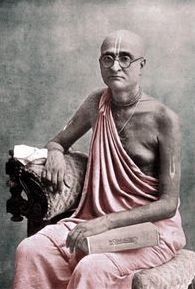
Bhaktisiddhanta Sarasvati was a highly influential preacher of Gaudiya Vaishnavism throughout India in the late 19th and early 20th Century. He was born as Bimala-prasad Dutta in the pilgrimage town of Jagannatha Puri, Orissa, India. His father was the Vaishnava scholar Sri Kedarnatha Dutta (also known as Bhaktivinoda Thakura) the first to present the teachings of Chaitanyite Vaishnavism to the English-speaking world and was a notable Gaudiya Vaishnava Theologian. Bimala Prasada was well known for having a fiery spirit, an acute intellect and for living a simple, austere lifestyle.
By the time he was twenty-five years old, Bimala-prasada had acquired an impressive reputation as a scholar of Sanskrit, mathematics, and astronomy. His astronomical treatise on the ‘Surya Siddhanta’ won him the title Siddhanta Sarasvati in recognition of his immense learning. In 1905, following the advice of his father, Siddhanta Sarasvati accepted spiritual initiation from Gaura-kisora Dasa Babaji. Siddhanta Sarasvati proved himself a capable assistant in the missionary work of his father.
Upon the passing of Bhaktivinoda Thakura in 1914, Siddhanta Sarasvati became editor of his father's journal, ‘Sajjana-tosani’, and founded the Bhagavata Press for publication of Vaishnava literature. Then in 1918, Siddhanta Sarasvati accepted the order of sannyasa (renounced order of life), assuming the title ‘Bhaktisiddhanta Sarasvati’. For the purpose of propagating the philosophy of Caitanya Mahaprabhu throughout India, he organized a mission called the Gaudiya Matha, with sixty-four branches throughout the country. The headquarters of the Gaudiya Matha, Sri Chaitanya Matha, was located in Mayapura, the birthplace of Caitanya Mahaprabhu.
Bhaktisiddhanta travelled the length and breadth of India - from Bengal to Orissa, to South India to Uttar Pradesh. During his many travels he met with kings, scholars, politicians, religious leaders, philsophers, British aristocracy and scientists.Some of the people he spoke with are listed below:
Sir John Anderson (Governor of Bengal)
Sir William Malcolm Hailey (Governor of the United Provinces)
Sir George Fredrick Stanley (Governor of Madras)
Virvikramkisor Devavarma Manikya Bahadur, the Maharaja of Tripura
Maharaja Krishnaraj Wodayar, king of Mysore State
Indira Devi (Queen of Cochbihar)
Prof. Albert E. Suthers of Ohio State University
Mr. Willion Henri Jan Vandor Stok of Batavia
Mrs. Nora Morell of Germany
Dr. Magnus Hirschfield of Berlin (a renowned psychologist)
Prof. Dr. Stella Kramrisch, M.A., Ph.D
Prof. Johans of St. Xaviers College
Satyadhanya Tirtha Swamiji of Uttaradi Math
Vasudeva Ramanuja of Embar Math, Ouri
General Punya Samaser Rana Jambahadur of Nepal
Pandit Madan-mohan Malavya
Dr. Ganganath Jha (Vice Chancellor of Allahabäd University)
Dr. Kalidas Nag (famous historian and professor at the University of Calcutta)
Dr. Dinesh Chandra Sen (famous writer and professor at the University of Calcutta),
Sri Janakinatha Bose (famous advocate and father of Subhash Chandra Bose)
Sri Birajmohan Mukhopadhyaya (Vice Principal of the Law College of the University of Calcutta)
Col. Dwaraka Prasad Goel (Principal of Calcutta Medical College)
Prof. K. Panchapagesan of Purukote College in Madras
Dr. Suniti Chatterjee of the University of Calcutta
Sri Ganesh Chandra Chanda (Superintendent of the Archaeological Division of Bihar)
Sri Khagendra Nath Mitra (Professor at Presidency College, Calcutta)
Mme. Maximiani Portas (French scholar)
Bhaktisiddhanta Sarasvati adjusted the traditions of Gaudiya Vaishnavism to the technological and the social condition of the twentieth century. He considered the printing press the most effective means of spreading Chaitanyite teachings throughout the world and was himself the author of many important translations, commentaries, and philosophical essays. In the early 30’s he sent some of his disciples to Europe for missionary work. This was revolutionary in the eyes of orthordox Hinduism as traditionally monks were not supposed to cross the ocean. Bhaktisiddhanta Sarasvati also implemented other innovations such as using automobiles and dressing his followers in British clothes in order to preach to the English aristocracy. One of the most controversial activities of Bhaktisiddhanta Sarasvati was his awarding the sacred thread to those that were not born as brahmanas. Many born brahmanas challenged him on this but using references from the Vedic scriptures he defeated all his opponents.
During his lifetime Bhaktisiddhanta wrote the following books:
'Bange samajikata' - a short work on various religious groups and philosophies in Bengal published in 1890.
'Brahmana o Vaishnaver Taratamya Visayaka Siddhanta' ('The Conclusion on the Comparison Between Brahmanas and Vaishnavas') An essay based on a famous lecture given by Bhaktisiddhanta at Midnapore. This book was published in 1911.
'Prakrta Rasa Sata Dusini' ('A Hundred Warnings Against Mundane Mellows') published in 1916
'Vaisnava Ke' (What Type of Vaishnava are You?) - a short Bengali poem of 19 verses describing the proper attitude of a follower of Chaitanya.
Bhaktisiddhanta also wrote commentaries to the most important books of the Gaudiya canon. Some of these include:
Commentary on Srimad Bhagavatam
Commentary on Chaitanya-bhagavata
Anubhasya commentary on Caitanya-caritamrta
Anuvrtti Commentary on Upadesamrta
Siksastakam vivrti commentary on Siksastakam
Additionally, hundreds of his discourses of were transcribed regularly by his followers and printed in the following periodicals published by the Gaudiya Matha:
The Harmonist (a fortnightly periodical in English)
The Gaudiya (in Bengali)
Sajjana-tosani (in Bengali)
Kirtana (in Assamese)
Paramarthi (in Oriya)
Bhagavata (in Hindi)
Bhaktisiddhanta also published a daily newspaper called 'Nadiya Prakash' from his center in Calcutta.
Bhaktisiddhanta's Gaudiya Matha published works by Bhaktivinoda Thakura, the Six Goswamis, Narottama Dasa Thakura and other teachers of the Gaudiya Vaishnava lineage. Some of the most important works he published include 'Jaiva-dharma', 'Harinama-chintamani', Prema-bhakti-chandrika', 'Bhakti-rasamrta-sindhu', and both Gita commentaries by Vishvanatha Chakravarti and Baladeva Vidyabhusana.
Bhaktisiddhanta Sarasvati was renowned for his bold stance against all false philosophies and pseudo-spiritual groups – especially those that posed themselves as followers of Chaitanya Mahaprabhu. Bhaktisiddhanta Sarasvati’s role in the Gaudiya Vaishnava movement of the 20th century should not be underestimated.
